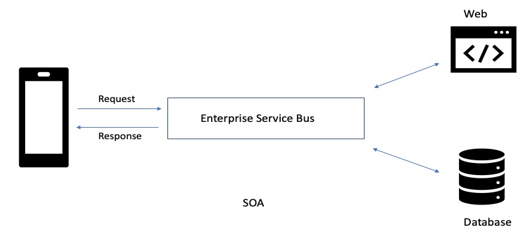Service Oriented Architecture (SOA) is a frequently used framework for integrating business processes and supporting IT infrastructure to address changing business priorities. In this blog we'll explain exactly what SOA is and how SOA can significantly improve performance of mobile applications.
Understanding Service Oriented Architecture
SOA is one of the major evolutions of distributed computing and is based on the request and reply communication for synchronous and asynchronous applications. It's an architectural approach in which applications make use of services available in the network. The services in this architecture are loosely coupled by nature, meaning that the service interface is independent of the application implementation.
One of the main advantages of using SOA is the ability to build applications by composing one or more services without additional implementation complexities. SOA can be implemented in J2EE or .Net, and the application or system consuming the SOA service can be on a different platforms and languages.
Below are the major roles in SOA architecture:

SOA and Microservices
Microservices is an architectural style evolved from SOA. Both are distributed architectures and both offer a decoupled paradigm. The SOA is heavier on infrastructure, whereas microservices offers a more flexible, lightweight development style. Typically, SOA is more frequently adopted by enterprises that have the resources to support more functionality.
Reasons To Use SOA
- Services are loosely coupled, so making changes to the service interface will not affect the application implementation.
- It's widely used in the market and can respond quickly to changes.
- Service implementation details of the subsystems are classified.
- Allows the interaction of new channels with customers, partners, and suppliers.
- It's platform-independent so companies can use the software or hardware of their choice.
Implementation Aspects of SOA in Mobile Devices
Today's mobile devices promote reuse of existing functionalities by providing SOA-like interactions. These Operating Systems can access built-in device features. Androids promote component-based development which are loosely coupled. The intent mechanisms allow components to interact with other components. By invoking intent, a component can use other features.
Mobile applications may have some limitations when compared to desktop applications, such as unreliable network performance and limited data storage. Mobile application development needs an innovative approach to web service invocation, data exchange, transformation, and user interface. The basic requirements include:
- High speed, robust and easy access to web services
- Transparency during connected, occasionally connected, and disconnected modes
- Loosely coupled system designed to combine services at runtime
- Low cost
- Lightweight application composition and development
The above requirements are fulfilled by SOA based development. Here are some proposed techniques while using SOA-based architecture for mobile devices.
- Identify only the data required by the user. This minimizes the amount of data transferred and stored on the device.
- Use lightweight and easily readable format JSON to transfer and store data.
- Pro-actively load data from the server.
- Provide asynchronous connectivity to the back-end system, allowing mobile applications to function even when disconnected.
Mobile applications use web services to populate data on a mobile screen. The below picture depicts the web services implementation using the SOA architectural pattern.

SOA Ecosystem for Mobile App Development
Businesses are adopting Service-Oriented Architectures to develop flexible, efficient and reusable applications. SOA ecosystems consist of:
- SOA Development Tools
- Service Requestor
- Service Provider
- Transport Mechanism
- SOA Management
- SOA Infrastructure
Ways SOA Changes the Game for Mobile Apps
Due to its strong ecosystem in the application implementation, SOA has many advantages to offer for mobile application development.
- Service Reusability: Applications are made from existing services which facilitates development of many more applications.
- Loosely Coupled: SOA architecture is loosely coupled, so it supports binding to other services while the app is running.
- Platform Independent: SOA architecture can create complex applications by combining services from different, platform-independent sources.
- Parallel Development: SOA is a layer-based architecture, so developers are able to create independent services in parallel.
- Scalability: SOA is a multi-layered architecture and can be clustered with appropriate load balancing to scale up.
- Rich Testability: These applications are more reliable, as they are easy to debug even for small services. It's easy to break up the testing process into different testing areas like services, security, governance, etc.
Limitations of SOA Implementation
There are some limitations with SOA implementation, such as complex service management and high overhead.
Another major concern is security. Mobile apps that provide access to back-end systems should be secure and communication between the server and the app must be encrypted. Any data stored on the device should also be encrypted.
The Public Key Infrastructure (PKI) cryptography is one of the best mechanisms for mobile applications. However, this encryption is slow on devices with limited computational power. The solution here could be to use asymmetric encryption for sensitive information. Securing SOA is crucial to make sure services and applications run safely.
About The Author
 Sreenivasulu Mannem works as Senior Team Lead at V-Soft Digital and has more than nine years' experience in mobile app development. His expertise includes many different mobile app development platforms like Android, Cordova, Kony, Xamarin and Flutter. He also has skills in web development languages like HTML, JavaScript, CSS.
Sreenivasulu Mannem works as Senior Team Lead at V-Soft Digital and has more than nine years' experience in mobile app development. His expertise includes many different mobile app development platforms like Android, Cordova, Kony, Xamarin and Flutter. He also has skills in web development languages like HTML, JavaScript, CSS.
















